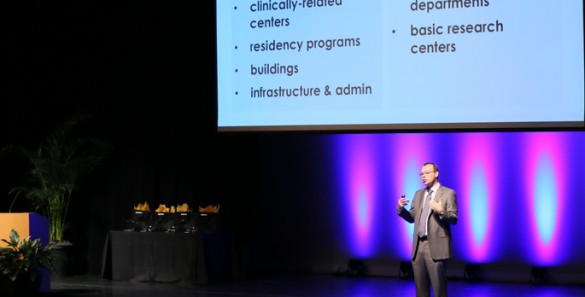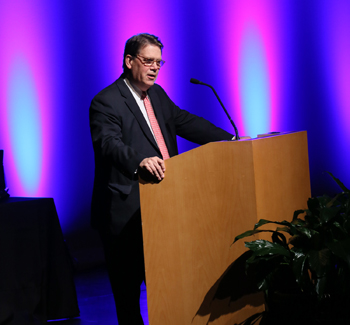
The Vanderbilt University Medical Center Spring Clinical Enterprise Leadership Assembly, held on May 21 at Langford Auditorium, highlighted ways the Medical Center is preparing to lead in a consumer-driven health care economy, where patients’ concerns over both cost and quality will drive industry change.
The theme of the well-attended assembly was transformational leadership. According to Jeff Balser, M.D., Ph.D., vice chancellor for Health Affairs and dean of the School of Medicine, market forces are aligning to make health care consumers more cost conscious and discerning about value. This trend can be summed up by the phrase “consumer driven health care,” and it’s going to transform the industry.
“Consumer driven health care is all about value and how we can make ourselves the most valuable health care option in the minds of consumers. That’s our challenge,” Balser said.
In step with this transformation, Balser envisions VUMC focusing even more closely on its strategic advantage in personalized medicine. He sketched a scenario in which care plans are designed to match each patient’s goals for health that are centered on what each patient values most regarding her or his quality of life.
Balser also predicted that the nation’s approximately 5,700 hospitals would align or consolidate over the next decade to form perhaps as few as 30 integrated health systems.
“Through the Vanderbilt Health Affiliated Network we’re building a leading system for the Southeast,” he said, explaining that this vision is what is prompting VUMC to reconstitute itself as an independent non-profit, as announced last year — a new entity that will continue to be very closely aligned in mission but legally separated from Vanderbilt University.
Balser said the trial phase for the VU-VUMC reorganization will start July 1 to allow for a period where infrastructure, systems and processes can begin to undergo testing, with the reorganization currently forecast to be completed approximately six months later. In addition to retaining all aspects of its clinical enterprise, VUMC will also continue to invest in and maintain vibrant programs in research, education and training.
“The new structure created through the VUMC-VU reorganization will continue to support our strategic commitments as a world-leading academic medical center,” he said.
A video of Balser’s Clinical Enterprise Leadership Assembly presentation, which provides an update on the VU-VUMC transition, is available on the Elevate website.

C. Wright Pinson, MBA, M.D., deputy vice chancellor for Health Affairs and CEO of the Vanderbilt Health System, was greeted with applause as he announced that employees of the Medical Center will receive a salary increase, effective Oct. 1. This and other news regarding VUMC’s improved financial performance so far this year lent a buoyant mood to the assembly. The salary increase will be for all VUMC employees in good standing with no disciplinary actions or performance plans, and have met all required annual training components.
“Through these salary increases and other market-based salary adjustments that have already been awarded this year, we are reinvesting in our people,” Pinson said.
During his quarterly Pillar update, Pinson provided a breakdown on VUMC’s performance regarding 2015 pillar goals across all five areas: People, Service, Quality, Growth & Finance and Innovation. He stressed the progress that has been made regarding efforts to improve patient access; in particular efforts to reduce unnecessary time patients may spend in the hospital and thereby shortening the average length of stay, which frees up additional inpatient capacity.
On the access front Pinson reported significant success over the past three business quarters reducing the time patients’ hold while waiting to speak with someone on the phone regarding an appointment or for other needs. The wait has been reduced to an average response time that is now under 30 seconds.
“This is a huge win. Access is a big deal and this is an important step,” he said. “In addition to these efforts we should all be asking ourselves how can I help improve patient access today?”
Pinson highlighted an initiative called Back to Basics, where VUMC is further investing in customer service training. He also called out inpatient fall prevention as a major fourth quarter quality priority for the adult clinical enterprise.
He urged participation in the VUMC employee survey, which will be held from June 1-15.
The assembly finished with a presentation on transformational leadership by health care entrepreneur Michael Burcham, MBA, senior lecturer in Policy Management at the Owen Graduate School of Management.
Burcham spoke about the five core aspects of health care disruption. During his remarks he spoke about the key considerations health care leaders must keep in mind to reorient work around the patient experience. Later, Burcham led breakout sessions where those in attendance participated in a dialogue about the importance of innovation and how technology can improve access and the delivery of patient care services.












